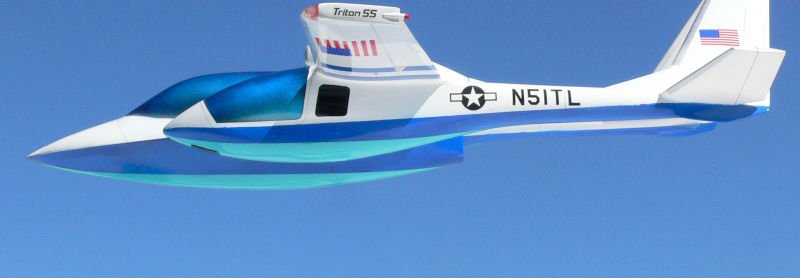
The Triton, Micronautix’s Luxury Aircraft Masterpiece

Say Goodbye to First Class and Hello to Panoramic Views and Stellar Accommodations
During the golden age of commercial flight in the 1960’s, airline travel was a luxury in itself. Surrounded by beautiful blonde waitresses, well-off clientele dressed professionally and enjoyed top-shelf drinks, plus an experience not offered elsewhere.
However, the 2000s have been cruel to the extravagance of commercial airline travel. Instead, we are shoved into sardine-sized cabins next to strangers in sweatpants, our elbows banged by passing carts serving tap water. With the unveiling of the Triton, a luxury aircraft concept designed by Micronautix, a Templeton, California-based company, at the 2014 Aviation Summit presented by Lift Event Management, those days could soon be over.
Instead of peering through about 15 x 11 inches of window on a 747, the Triton offers panoramic, breathtaking views, making for a distinctive flying and sightseeing escapade. On a normal commercial flight, passengers count the minutes until their plane lands in the destination, however on the Triton, passengers will get unsurpassed views of their favorite mountain ranges, beaches, and landmarks. “The Triton will provide panoramic views and luxury car-like accommodation in a fighter jet-like environment that sitting in the back seat of today’s average GA aircraft just can’t provide,” said Charlee Smith, founder of Micronautix.
Marco Parotto, President of Lift Event Management, added that in terms of well-being and relaxation, “The goal is to make the passengers, many of whom will be taking their first flight in a small aircraft, as comfortable as if they would be sitting in a $40,000 mid-size sedan.”
Usually, these types of views are only afforded to single-seat high performance aircraft and military pilots. The model could be a huge hit for owner-flyers, air taxis and air tour operators.
Equipped with three accommodated cockpits, the Triton houses one pilot and passenger in the center cockpit, and is then surrounded by up to two passengers in each of the two side cabins, similar to a sidecar on a motorcycle. The aircraft uses a sleek, aerodynamic design which doesn’t stray too far from a typical model, so that issues such as balance and CG control (which is caused by varying passenger loads) can be managed appropriately.
With a wingspan of 42 feet, the Triton is powered by a 450 horsepower turboprop, swinging a large prop at lower RPM for reduced noise and added comfort. Given that the aircraft was created for these luxury purposes instead of speed, Micronautix gave the Triton a cruise speed of about 193 miles per hour and a range of 932 miles, with an empty weight of 2546 pounds. The company plans to offer several models, including an amphibian and electronic hybrid, “which will provide up to 20 minutes of near silent flight over noise-sensitive areas,” such as national parks, said Smith and reported by flightglobal.com.
 Micronautix, which includes Smith, Parrotto, and Brian Reed, a contractor who created the computer aided design, developed the Triton as a result of the obvious hole in the aircraft marketplace. Being that airplane simulators and video games still maintain high popularity, it was clear that the urge to be in the air still existed, yet an aircraft that offered an unparalleled view was lacking. Even in popular flight sightseeing, passengers remain behind the pilot and their only opportunity is to view scenery from a side window, giving obstructed views that lack interesting angles.
Micronautix, which includes Smith, Parrotto, and Brian Reed, a contractor who created the computer aided design, developed the Triton as a result of the obvious hole in the aircraft marketplace. Being that airplane simulators and video games still maintain high popularity, it was clear that the urge to be in the air still existed, yet an aircraft that offered an unparalleled view was lacking. Even in popular flight sightseeing, passengers remain behind the pilot and their only opportunity is to view scenery from a side window, giving obstructed views that lack interesting angles.
Micronautix believed that a safe and quiet design such as that of the Triton would present a spike in sightseeing passengers, looking to fly over beautiful destinations such as the Grand Canyon, Hawaii, Lake Tahoe, and Key West. About ten years later, the idea and configuration evolved into a stunning design and was then refined into what is now the Triton.
As of now, however, the Triton remains a concept rather than a production. Micronautix has approached several original equipment manufacturers, including General Atomics Aeronautical Systems, Extra Aircraft and Aurora Flight Sciences, but the feedback insists that they would be happy to assist but first, Smith needs to come up with millions to finance it.
To further purify the engineering and have an outside company construct the tooling and produce a full-size flying prototype would require a $5 to $7 million investment, said Parrotto. This would depend upon whether it is equipped with a fixed or retractable main landing gear and the level of avionics. Smith said, “I would be willing to hand over the design rights to the most suitable company, just to see the Triton become a reality.”
Since the design is complete, the next step is to find a reputable aerospace firm that understands the hole in the marketplace for luxury flight so that engineers can bring the Triton to life. Fittingly, a one-sixth and one-tenth model will be unveiled at the 2014 Aviation Summit from October 31 to November 2 at the Palm Springs Convention Center, where 10,000 international pilots and industry experts will attend to learn about new products, receive technical advice from manufacturers and participate in hands-on demonstrations.
Besides the significant sums required bringing an aircraft to fruition, Smith understands the other challenges faced and the possibility of failure, but he isn’t giving up yet. He said, “Aviation history is filled with failed concepts that designers have attempted to bring to market by themselves. I feel the positive impact the Triton can have on aviation is more important than my own personal gain.”
Smith sees the greater good in his design and is hopeful and positive about its creation following the 2014 Aviation Summit. He said, as reported by Scott Oxarat in Aviation Digest, “Most people who experience flying in a Triton will feel the magic of flight and want more. Many will be inspired to work toward becoming a pilot because of this.”
According to Parrotto, the Triton’s key impact will be the end of today’s trend of most people being content with virtual flight experiences beyond flying an airliner from one point to another. He said, “The average person on the street will say ‘I want to fly in that airplane,’ which will be an experience that will be the seed to the revitalized growth of general aviation.”














![Cozy whisky cocktails for winter evenings at home [COCKTAIL TIME]](https://luxebeatmag.com/wp-content/uploads/2022/01/SW_Michelin_1920x1080px-updated-440x264.jpg)




















